Introduction
In the fast-paced world of corporate finance, organizations often face periods of financial distress that can threaten their very existence. Enter the turnaround manager—a specialist equipped with the skills and strategies necessary to navigate these turbulent waters. This article delves into the crucial role of turnaround managers, highlighting their ability to conduct thorough financial assessments and implement strategic interventions.
It explores the essential traits that make these managers effective, such as decisiveness, analytical prowess, and resilience. Additionally, the stages of business turnaround management are broken down, from risk assessment to the implementation and monitoring of recovery plans. The article also outlines common recovery strategies, including cost-cutting measures, debt restructuring, and enhancing customer engagement.
Finally, it addresses the common pitfalls to avoid and emphasizes the importance of effective leadership in ensuring the long-term success of turnaround efforts.
The Role of Turnaround Managers
Turnaround managers are instrumental in guiding distressed organizations back to health. Their main objective is to conduct a thorough assessment of the company's current financial situation, diving deep into balance sheets, income statements, and cash flow statements. This comprehensive review helps pinpoint underperforming areas, enabling informed decisions on whether to discontinue certain products or enhance their sales.
Alongside financial analysis, recovery managers scrutinize operational processes and market positioning. By utilizing their expertise, they create customized plans aimed at tackling specific challenges. For example, a company facing a significant revenue decline might identify weak points through detailed financial reviews, leading to strategic decisions that drive recovery.
This approach is not without its complexities. Restructuring efforts fundamentally alter the operational and organizational fabric of a company, aiming to improve efficiency, reduce costs, and shift strategic focus. However, this metamorphosis can also bring uncertainty regarding job security, changes in roles, and potential shifts in work culture. Identifying these challenges is essential for a successful recovery.
By creating tailored approaches, recovery managers play an essential part in directing organizations towards stability and expansion, ensuring lasting financial well-being.
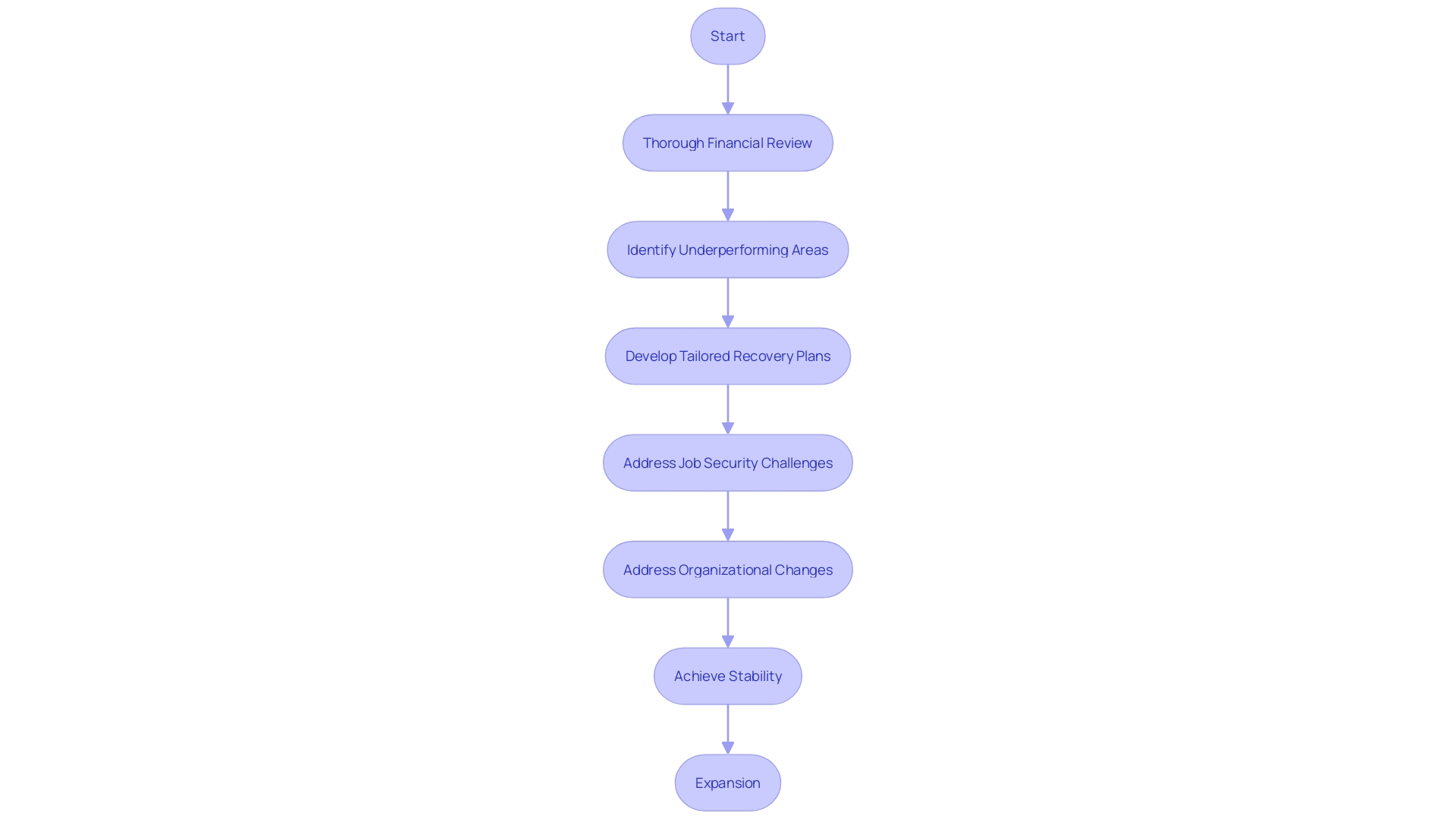
Key Traits of Effective Turnaround Managers
Effective turnaround managers possess a distinct blend of skills and attributes that set them apart in crisis situations. They are decisive, making tough calls swiftly when necessary. This decisiveness was evident in the Japan Airlines incident, where swift evacuation procedures saved lives in an unprecedented crisis. Analytical prowess is another vital trait, as it enables managers to break down complex problems swiftly and accurately, ensuring that no detail is overlooked.
Communication is paramount in such scenarios. The HSMAI Global Distribution Advisory Board emphasizes the importance of clear, timely communication during crises, ensuring that information is relayed effectively even when traditional systems fail. Turnaround managers must rally teams and stakeholders around a unified vision, fostering a sense of purpose and direction.
Moreover, resilience and adaptability are crucial. These managers must navigate the uncertainties inherent in recovery efforts, adjusting strategies as new challenges arise. Regular rehearsals and drills, as suggested by the HSMAI, prepare entities to remain agile and responsive, ensuring readiness for any eventuality. This combination of decisiveness, analytical ability, communication, resilience, and adaptability equips managers to guide their organizations through turbulent times effectively.
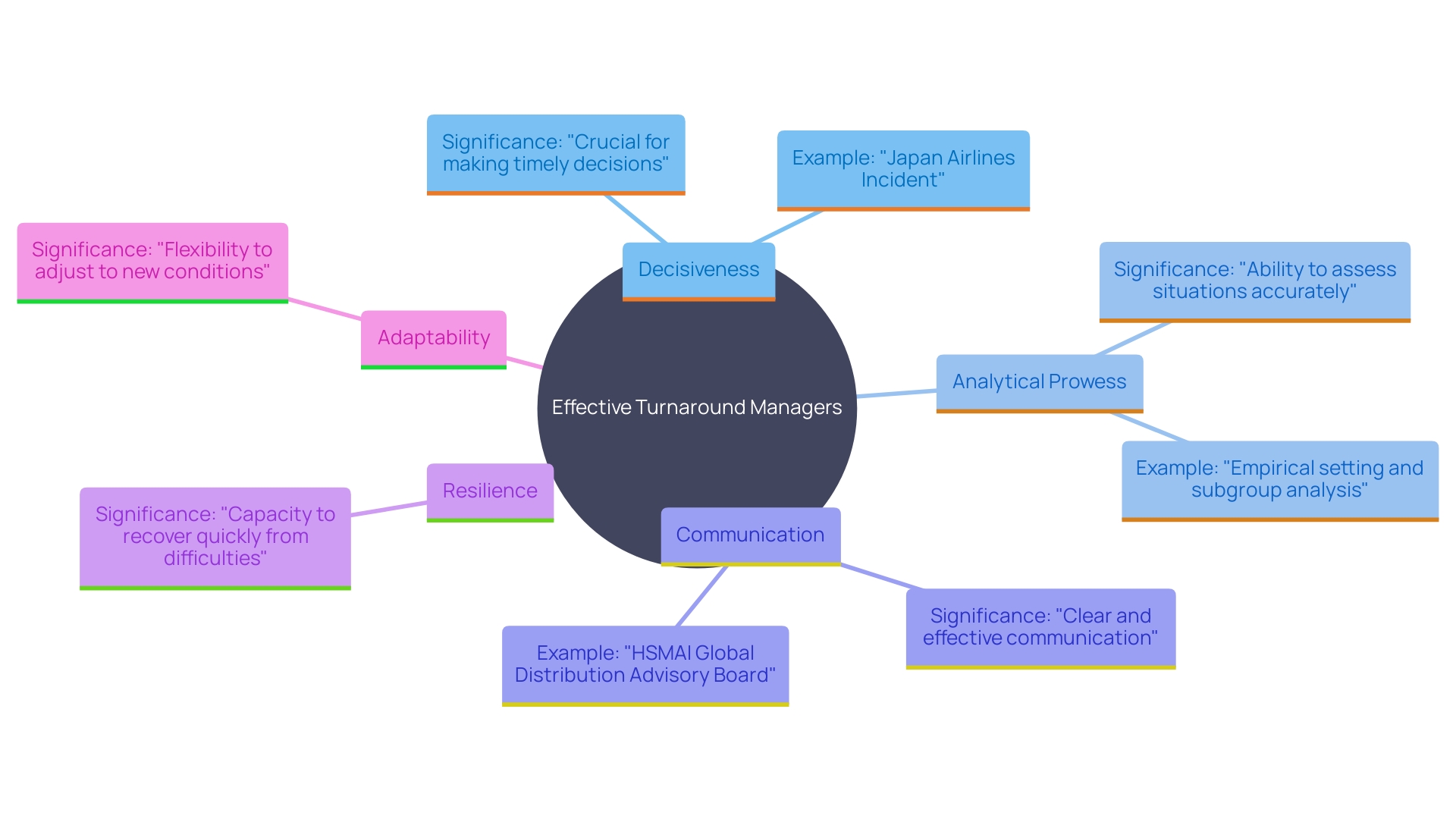
Stages of Business Turnaround Management
The recovery process unfolds through several critical stages. Initially, it starts with a risk assessment and a comprehensive business impact analysis. This involves reviewing all financial statements, including the balance sheet, income statement, and cash flow statement, to understand the financial health of the company and pinpoint areas needing immediate attention. Personnel from various departments, including human resources, legal, facilities, IT, security, and finance, are typically involved in this phase.
Next, managers stabilize operations by addressing identified risks and developing a comprehensive recovery plan. This approach considers impacts on people, facilities, legal obligations, finances, reputation, the community, and the environment. It also determines the maximum allowable time to recover from disruptive incidents and provides communication channels for employees, stakeholders, and the media.
Finally, the implementation of the plan is closely monitored. Management must regularly review and test the plan, making necessary adjustments to ensure objectives are met. This ongoing observation and enhancement procedure is vital for the success of the recovery plan, ensuring the organization can adjust and prosper in the face of challenges.

Common Turnaround Recovery Strategies
To successfully navigate an organizational turnaround, employing a range of strategies is essential. One effective approach is implementing cost-cutting measures. These should be carefully assessed for their ease of implementation, the time and resources required, and their impact on customer satisfaction and loyalty. 'Cost-reduction strategies must also adhere to legal and regulatory standards and should not elevate the entity's risk exposure.'. Creative solutions or technology that lower expenses without sacrificing quality can be especially beneficial. Additionally, eco-friendly cost-cutting measures align with social responsibility goals and can lead to significant savings.
Restructuring debt is another critical strategy. By renegotiating terms with creditors, companies can lower interest payments and extend maturities, easing cash flow pressures. This approach can be especially beneficial for companies facing immediate financial distress.
Improving operational efficiencies is also key. Leveraging technology and refining processes can streamline operations, reduce waste, and enhance productivity. For instance, adopting lean techniques in manufacturing or service delivery can lead to more efficient use of resources and better overall performance.
Enhancing customer engagement is vital for revitalizing a business. Understanding customer needs and preferences allows for more targeted marketing strategies and improved service delivery. A strategic focus on customer satisfaction can lead to great reviews and increased sales, as demonstrated by a major branded hotel that leveraged its central location to attract more diners to its restaurant.
Exploring new revenue streams can provide the necessary boost for a turnaround. Identifying untapped markets or diversifying product offerings can help stabilize revenues. For instance, a grant for a vehicle can greatly enhance operational efficiency and broaden service capabilities for mobile enterprises, allowing them to reach more customers and lower transportation expenses.
Every approach must be customized to the organization's unique situation, ensuring alignment with both immediate needs and long-term goals. By carefully implementing these strategies, businesses can navigate through challenging times and emerge stronger.
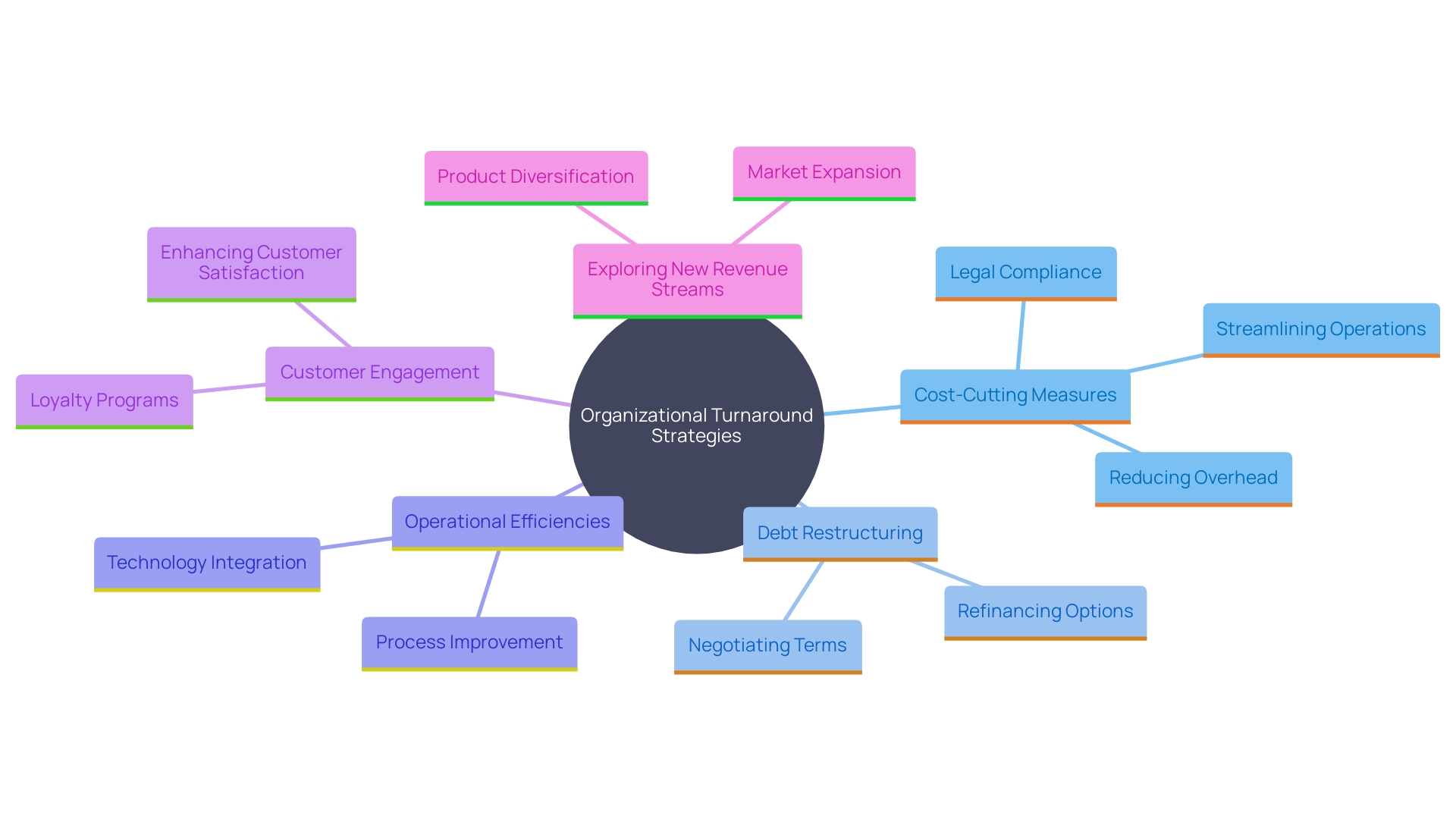
Avoiding Common Pitfalls in Turnaround Management
Turnaround efforts can yield significant benefits, but several common pitfalls often impede success. One major challenge is failing to prioritize transparent communication. Departments often hoard critical data, leading to misunderstandings and inefficient decision-making. A lack of transparency about the objectives and benefits of the turnaround can breed resistance among stakeholders, jeopardizing the initiative. As emphasized in a recent digital transformation case, the lack of clear communication can impede progress and obstruct the free flow of information throughout a company.
Additionally, it's crucial to focus on securing quick wins to maintain morale and trust within the team. Employee engagement, which is a key indicator of organizational stability, is significantly influenced by early successes. Statistics show that about 72% of workers globally are engaged with their jobs, but this engagement can quickly wane if short-term victories are not achieved and celebrated.
Another critical aspect is balancing short-term recoveries with long-term sustainability. Leaders must pinpoint and address key areas that could hinder the entity, such as unrealistic performance targets and inefficient decision-making processes. For example, a pharmaceutical CEO once emphasized the importance of aligning on the main issue to be solved to ensure business growth and employee care. This approach helps set a useful framework for debate and decision-making.
Finally, the importance of responsible communication cannot be overstated. When weighing whether to communicate about an issue, consider its relevance and impact on employee safety and well-being. By maintaining focus on both short-term recoveries and long-term sustainability, and by fostering transparent communication, entities can navigate the complexities of recovery efforts more effectively.
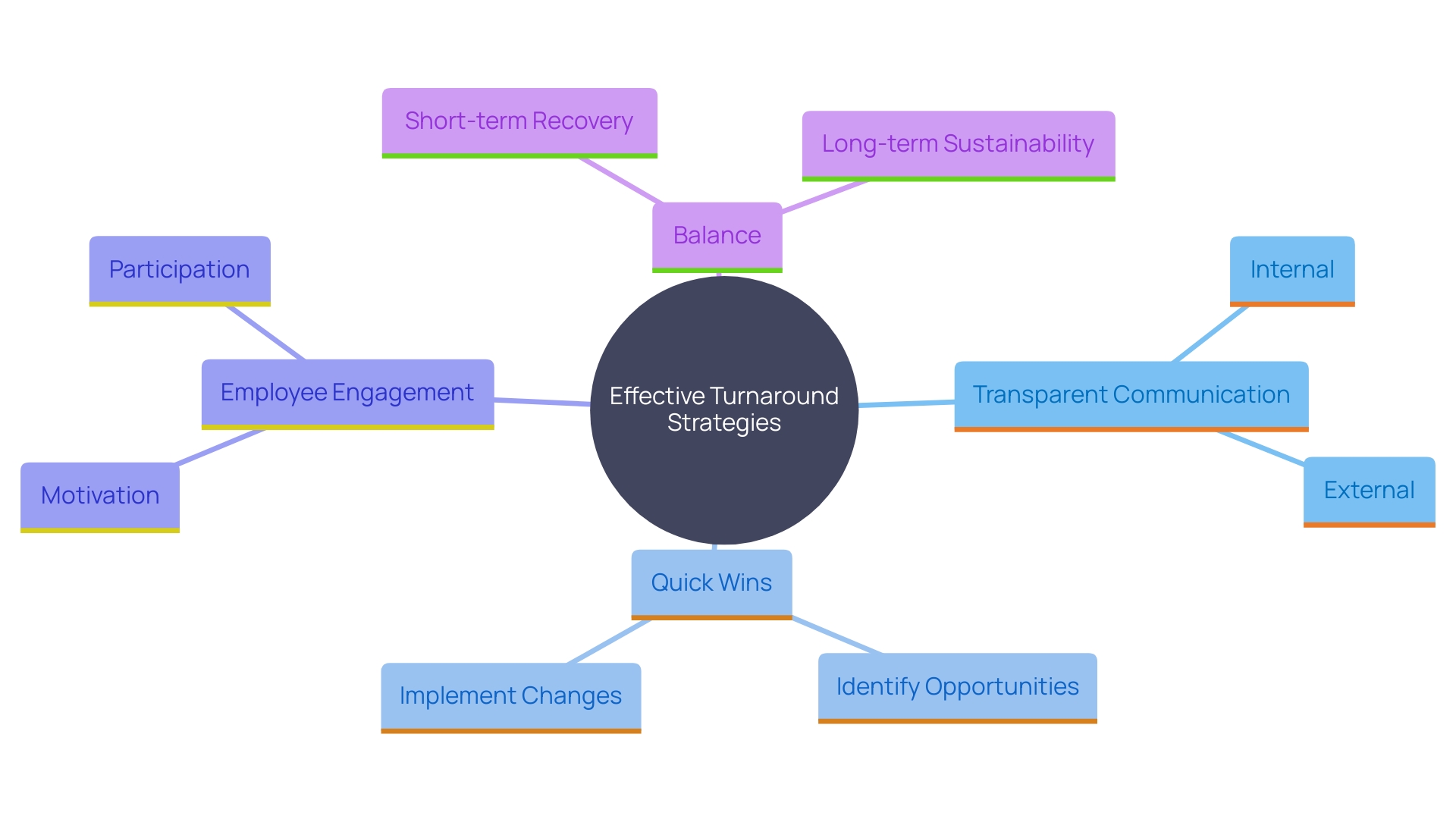
The Importance of Leadership in Turnarounds
Effective leadership is the cornerstone of any successful recovery. Leaders must not only instill confidence but also cultivate a culture of accountability within the organization. For example, Starbucks' turnaround was significantly influenced by Howard Schultz's leadership, who revitalized the company's vision and approach. By clearly articulating the vision and strategy, leaders can unite teams towards common goals. This is echoed by Bryan Solis, who highlights that 51% of changes in companies are driven by market competition and growth opportunities. Strong leadership facilitates better decision-making and encourages a proactive approach to problem-solving, which is essential for navigating the complexities of a turnaround. Robert Hurley emphasizes the importance of stewardship in leadership, stating that a leader's job is to energize and facilitate, not to dominate and control. This approach helps in addressing challenges and leveraging the system's strengths, leading to a more cohesive and resilient organization.
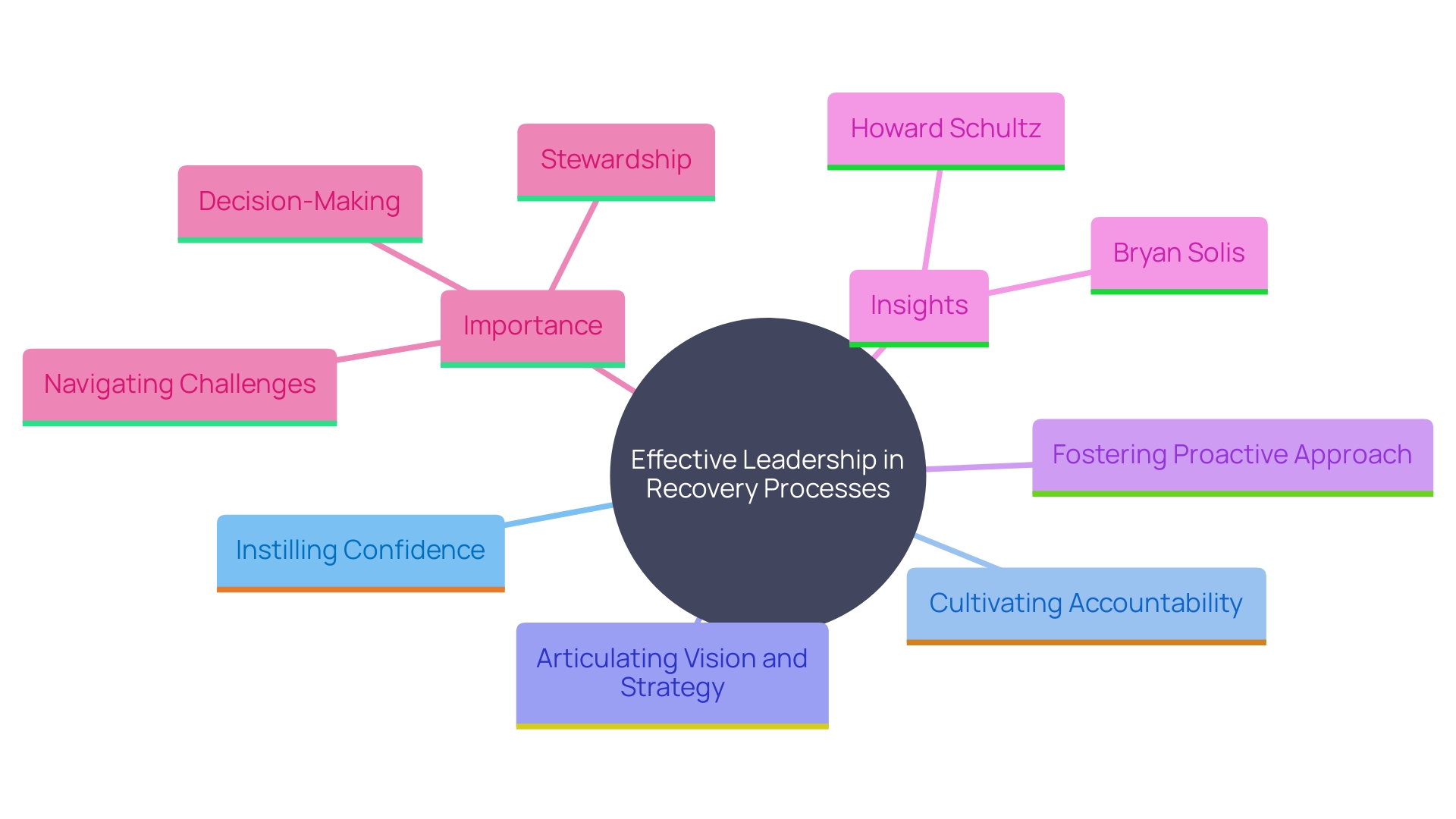
Conclusion
Turnaround managers play a vital role in steering distressed organizations back to stability. Through comprehensive financial assessments and tailored strategies, they identify weaknesses and implement necessary changes, ultimately aiming to enhance operational efficiency and drive recovery. Their ability to navigate complex challenges while fostering a culture of accountability is essential for achieving long-term financial health.
Key traits such as decisiveness, analytical prowess, effective communication, resilience, and adaptability equip turnaround managers to tackle crises effectively. These attributes enable them to make quick, informed decisions and rally teams around a unified vision, ensuring that everyone is aligned and motivated throughout the turnaround process.
The stages of business turnaround management emphasize the importance of thorough risk assessment, stabilization, and continuous monitoring. By employing various recovery strategies—ranging from cost-cutting measures and debt restructuring to enhancing customer engagement—organizations can not only survive challenging times but also position themselves for future growth. Each strategy must be customized to fit the unique circumstances of the organization, ensuring alignment with both immediate needs and long-term goals.
Avoiding common pitfalls, such as poor communication and neglecting employee engagement, is crucial for successful turnaround efforts. Leaders must maintain transparency and focus on quick wins to build morale and trust. Ultimately, strong leadership is the backbone of effective turnaround management, driving the organization toward a cohesive and resilient future.
By embracing these principles, organizations can successfully navigate the complexities of financial distress and emerge stronger than before.




